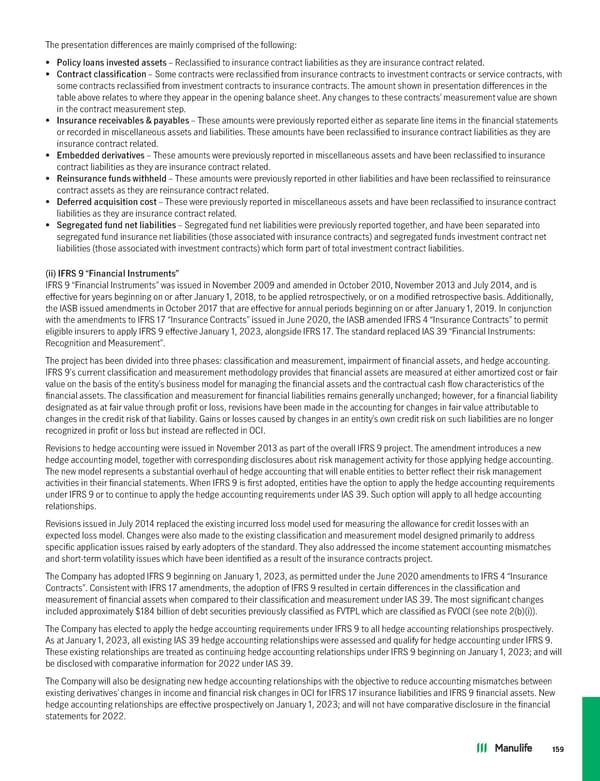The presentation differences are mainly comprised of the following: • Policy loans invested assets – Reclassified to insurance contract liabilities as they are insurance contract related. • Contract classification – Some contracts were reclassified from insurance contracts to investment contracts or service contracts, with some contracts reclassified from investment contracts to insurance contracts. The amount shown in presentation differences in the table above relates to where they appear in the opening balance sheet. Any changes to these contracts’ measurement value are shown in the contract measurement step. • Insurance receivables & payables – These amounts were previously reported either as separate line items in the financial statements or recorded in miscellaneous assets and liabilities. These amounts have been reclassified to insurance contract liabilities as they are insurance contract related. • Embedded derivatives – These amounts were previously reported in miscellaneous assets and have been reclassified to insurance contract liabilities as they are insurance contract related. • Reinsurance funds withheld – These amounts were previously reported in other liabilities and have been reclassified to reinsurance contract assets as they are reinsurance contract related. • Deferred acquisition cost – These were previously reported in miscellaneous assets and have been reclassified to insurance contract liabilities as they are insurance contract related. • Segregated fund net liabilities – Segregated fund net liabilities were previously reported together, and have been separated into segregated fund insurance net liabilities (those associated with insurance contracts) and segregated funds investment contract net liabilities (those associated with investment contracts) which form part of total investment contract liabilities. (ii) IFRS 9 “Financial Instruments” IFRS 9 “Financial Instruments” was issued in November 2009 and amended in October 2010, November 2013 and July 2014, and is effective for years beginning on or after January 1, 2018, to be applied retrospectively, or on a modified retrospective basis. Additionally, the IASB issued amendments in October 2017 that are effective for annual periods beginning on or after January 1, 2019. In conjunction with the amendments to IFRS 17 “Insurance Contracts” issued in June 2020, the IASB amended IFRS 4 “Insurance Contracts” to permit eligible insurers to apply IFRS 9 effective January 1, 2023, alongside IFRS 17. The standard replaced IAS 39 “Financial Instruments: Recognition and Measurement”. The project has been divided into three phases: classification and measurement, impairment of financial assets, and hedge accounting. IFRS 9’s current classification and measurement methodology provides that financial assets are measured at either amortized cost or fair value on the basis of the entity’s business model for managing the financial assets and the contractual cash flow characteristics of the financial assets. The classification and measurement for financial liabilities remains generally unchanged; however, for a financial liability designated as at fair value through profit or loss, revisions have been made in the accounting for changes in fair value attributable to changes in the credit risk of that liability. Gains or losses caused by changes in an entity’s own credit risk on such liabilities are no longer recognized in profit or loss but instead are reflected in OCI. Revisions to hedge accounting were issued in November 2013 as part of the overall IFRS 9 project. The amendment introduces a new hedge accounting model, together with corresponding disclosures about risk management activity for those applying hedge accounting. The new model represents a substantial overhaul of hedge accounting that will enable entities to better reflect their risk management activities in their financial statements. When IFRS 9 is first adopted, entities have the option to apply the hedge accounting requirements under IFRS 9 or to continue to apply the hedge accounting requirements under IAS 39. Such option will apply to all hedge accounting relationships. Revisions issued in July 2014 replaced the existing incurred loss model used for measuring the allowance for credit losses with an expected loss model. Changes were also made to the existing classification and measurement model designed primarily to address specific application issues raised by early adopters of the standard. They also addressed the income statement accounting mismatches and short-term volatility issues which have been identified as a result of the insurance contracts project. The Company has adopted IFRS 9 beginning on January 1, 2023, as permitted under the June 2020 amendments to IFRS 4 “Insurance Contracts”. Consistent with IFRS 17 amendments, the adoption of IFRS 9 resulted in certain differences in the classification and measurement of financial assets when compared to their classification and measurement under IAS 39. The most significant changes included approximately $184 billion of debt securities previously classified as FVTPL which are classified as FVOCI (see note 2(b)(i)). The Company has elected to apply the hedge accounting requirements under IFRS 9 to all hedge accounting relationships prospectively. As at January 1, 2023, all existing IAS 39 hedge accounting relationships were assessed and qualify for hedge accounting under IFRS 9. These existing relationships are treated as continuing hedge accounting relationships under IFRS 9 beginning on January 1, 2023; and will be disclosed with comparative information for 2022 under IAS 39. The Company will also be designating new hedge accounting relationships with the objective to reduce accounting mismatches between existing derivatives’ changes in income and financial risk changes in OCI for IFRS 17 insurance liabilities and IFRS 9 financial assets. New hedge accounting relationships are effective prospectively on January 1, 2023; and will not have comparative disclosure in the financial statements for 2022. 159
 2022 Annual Report Page 160 Page 162
2022 Annual Report Page 160 Page 162